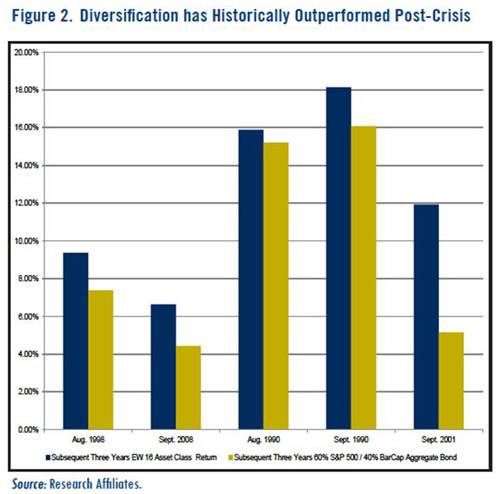 If the price of tuna doubled over a three-year period, you would expect consumption to plummet. Even people who loved the “Chicken of the Sea” would look elsewhere for their protein. But, come a sudden 30% to 50% markdown, buyers would flock back in to the store shelves. That’s because, in every aspect of our economic life, our unconscious mantra is -- High Prices = bad. Low prices = good. And 2 for 1 is even better!
If the price of tuna doubled over a three-year period, you would expect consumption to plummet. Even people who loved the “Chicken of the Sea” would look elsewhere for their protein. But, come a sudden 30% to 50% markdown, buyers would flock back in to the store shelves. That’s because, in every aspect of our economic life, our unconscious mantra is -- High Prices = bad. Low prices = good. And 2 for 1 is even better!
But when people walk through the magical door marked “investments”, something profoundly weird happens. Suddenly (though still unconsciously), it is high prices = good. Low prices = bad.
So, I have searched through history for a measurement tool to provide more “meat” to the conversation than price alone can provide. Today people are very uncertain. Unemployment still looms over 9 percent for the 3rd year, we have weak consumer confidence and many economists and investors predicted a double dip recession over the last year.
While these factors are certainly concerning, they are secondary or tertiary indicators. They influence the future, but do not predict it with much certainty. In the end, the stock market has, and always will be, about price compared to value.
American companies have finished 2011 with historically strong profits thanks to effective management, cost cutting and postponing some projects. Add to that strong balance sheets and some strategists I listen to regularly (we’re talking people who have been at it for 40 years) have said that American companies are in the strongest position ever in their careers.
The recent fear last fall about the future of the US economy has caused a significant dislocation between the government bond market and S&P 500 earnings. US government debt has been bid up to record-low yields while S&P 500 earnings continue to increase. To illustrate the dislocation, we prepared the following charts. Chart 1 gives a very long-term historical perspective and chart 2 zooms into modern day.
 CHART #1 Source: Forbes.com
CHART #1 Source: Forbes.com
The earnings yield of the S&P 500 shows the percentage earned by the company for each dollar invested in the stock.
Money managers often compare the earnings yield of a broad market index (such as the S&P 500) to prevailing interest rates, such as the current 10-year Treasury yield. If the earnings yield is less than the rate of the 10-year Treasury yield, stocks as a whole may be considered overvalued. If the earnings yield is higher, stocks may be considered undervalued relative to bonds.
Economic theory suggests that investors in equities should demand an extra risk premium of several percentage points above prevailing lower risk rates (such as T-bills) in their earnings yield to compensate them for the higher risk of owning stocks over bonds and other asset classes.
And investors typically purchase Treasury securities when they are worried about markets and the economy, which moves the yield on the note down (remember price and yields of bonds move inversely).
Think about it for a moment, when the government reduces interest rates investors are forced to find their required income from some other place. So they need to take on more risk. The average retiree gets it because they live it, but many forget that institutions are also required to satisfy unfunded liabilities like pension payments and endowment returns.
Take a closer look at both charts and you will also notice the date of the worst time to own stocks vs. bonds. You can see the EYS dove to -5.7 below on October 9th 1987. That was 10 days before the worst stock market crash in modern history. So while this is not infallible by any stretch of our imagination, I think it has some validity to overweighting one asset class vs. another when it signals along with some other gauges.
 CHART #2 Source: Forbes.com
CHART #2 Source: Forbes.com
Chart #2 provides a closer viewpoint of our current spread. I have heard indications by strategists of the spread approaching 8 in the last quarter. A reading of 8 would be of historic proportions, because it has only happened 3 times in the last 140 years of stock market history.
- Around the time of Francis Ferdinand Assassination 1914 (beginning of WWI).
- Post WWII recession period 1946/48 when demand fell out of bed (since the war machine was being dismantled and yields on bonds were low but fear was still on the minds of investors).
During the first two instances, just like now, there was a good reason for fear in the world and we went into two very ugly world wars. However, in hindsight, they were very good points to enter the equity markets.
 In general, long-term investors were handsomely paid if they began to purchase and continued to purchase equity positions vs. bond positions when the Earnings Yield Spread was high. That disparity between equity return expectations is one of the reasons The Center determined to stay fully invested in our equity exposure during the summer and fall of 2011. So, the moral of the story is to buy tuna (or stocks, as the case may be) when it is being sold at a discount. And if the price is considerably less than your other protein options and you like it…maybe buy a little more. But for heaven sakes, it’s not time to give up tuna altogether!
In general, long-term investors were handsomely paid if they began to purchase and continued to purchase equity positions vs. bond positions when the Earnings Yield Spread was high. That disparity between equity return expectations is one of the reasons The Center determined to stay fully invested in our equity exposure during the summer and fall of 2011. So, the moral of the story is to buy tuna (or stocks, as the case may be) when it is being sold at a discount. And if the price is considerably less than your other protein options and you like it…maybe buy a little more. But for heaven sakes, it’s not time to give up tuna altogether!











